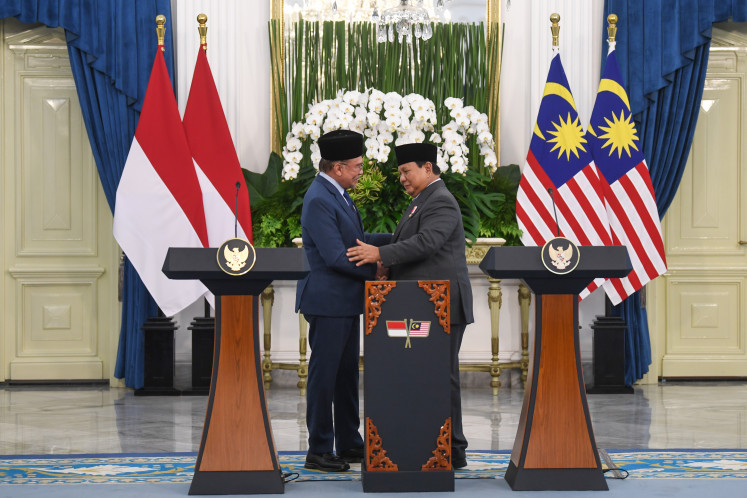Popular Reads
Top Results
Can't find what you're looking for?
View all search resultsPopular Reads
Top Results
Can't find what you're looking for?
View all search resultsA kaleidoscope of Indonesian film
Bing Slamet in Koboi Cengeng (1974)
Change text size
Gift Premium Articles
to Anyone

B
span class="caption" style="width: 248px;">Bing Slamet in Koboi Cengeng (1974).With the little available documentation of Indonesian film, whatever materials are available ' the restoration of old films, movie-related posters and postcards ' are always prized by film buffs.
JB Kristanto's diligently researched catalog of Indonesian film from 2005 provided a chronological detailing from the mid-1920s on, with a synopsis of each vehicle, cast and crew lists and, occasionally, other interesting tidbits of information (for example, the film historian notes that 1971's Tiada Maaf Bagimu was the first Indonesian movie to include a lesbian scene). Complete in its provision of a basic grounding in Indonesian film knowledge, its only 'drawback' was a shortage of stills.
A new addition is A Brief Cultural History of Indonesian Cinema, a lavishly illustrated English-language book published by the Ministry of Education and Culture in 2012. The purpose of the book, according to Education and Culture Minister Mohammad Nuh in his foreword, '['¦] is to give an overview of the rich history of Indonesian cinema; to generate a deeper understanding of its valuable heritage, especially by the younger generation; and to contribute to the preservation of our cultural roots through the power of film'.
As an overview, it succeeds in tracing the important developments in Indonesian film in precise and no frills English. It begins with a detailing of the first Dutch-led cinematic efforts in the then Dutch East Indies, through to the true birth of Indonesian film with Loetoeng Kasaroeng, which featured an Indonesian story and an Indonesian lead actress, Martoana, the daughter of the Bandung regent of the time (however, there was a German cinematographer and Dutch producer/director).
The book notes that movies quickly gained popularity among the local populace; in 1926, an estimated 80 percent of cinemagoers were locals, and 10 years later there were 225 movie theaters in the archipelago (there are beautiful images of those old-time movie theaters, most of them now demolished).
World War II led to the Japanese occupation; in the essay, 'The Birth of Indonesian Cinema and Its Pioneers [1950s-1960s]', Lisabona Z. Rahman argues that it was during the war that Indonesians artists such as Usmar Ismail and D. Djajakusuma discovered filmmaking and developed their technological expertise through training and encouragement to make films in Indonesian.
'That was when we understood that what must be our weapon is cinema, and we pledged that we would create an Indonesian cinema,' Djajakusuma is quoted as saying. 
But it was the 1970s and 1980s that are considered the heyday of Indonesian film. In the chapter, 'The Artistic, The Commercial and The Prolific (1970s-1980s), Corneles Alberto Joris writes there was a tremendous increase in local film production in the 1970s, from only 21 titles in 1970 to 124 films in 1977. He attributes the fact partly to the restrictions on imports on foreign films during the decade.
'Many of the films produced during this time were of questionable quality, but new talents kept emerging, and the spirit to create films soared. Genres varied from drama and comedy to martial arts, action, horror and hybrid forms of these that dominated theaters from the late 1970s into the 1980s and 1990s,' Joris writes.
Three great directors of Sjuman Djaya, Arifin C. Noer and Teguh Karya were in ascendance, and there was also the rise of big-time movie stars; he calls them 'The Big Five' of Jenny Rachman, Yati Octavia, Doris Callebaut, Roy Marten and Roby Sugara. With legion fans turning out for their movies, they were reportedly paid the then fantastic sum of Rp 5 million (US$505) per film.
What Joris terms 'the good times' continued in the 1980s with teen romances, the famous Warkop DKI trio of comedies and B movies, before the dark days of the 1990s when local movie production almost ground to a standstill amid the influx of foreign movies (the middle years of the decade features a lot of titles referring to 'passion' and 'ecstasy', the latter often times carrying a double meaning for not only the state of euphoria but also the flourishing drug culture).
Thankfully, the end of the decade saw a resurgence of local film fortunes, ironically with the children's movie Petualangan Sherina (Sherina's Adventure). The efforts of young, idealistic and talented filmmakers ' Mira Lesmana, Riri Riza, Nia Dinata, Joko Anwar, among many others ' are bringing Indonesian movies to local and international audiences.
As well as corny comedies and ghost flicks, they explore themes ' religion, social mores ' relevant to Indonesia today.
The message from many of the essayists is that more needs to be done to support Indonesian movies outside of purely commercial enterprises, but for creativity.
'More direct support would surely strengthen Indonesian cinema and safeguard the uniquely Indonesian cultural character,' writes actor-director Slamet Rahardjo Djarot.
This is a fascinating book, especially for its historical trail of rare images of yesteryear. Hopefully, aside from its distribution for educative and promotional endeavors by the ministry, it will also reach a wider audience of readers hungry to know more about the development of Indonesian cinema.









